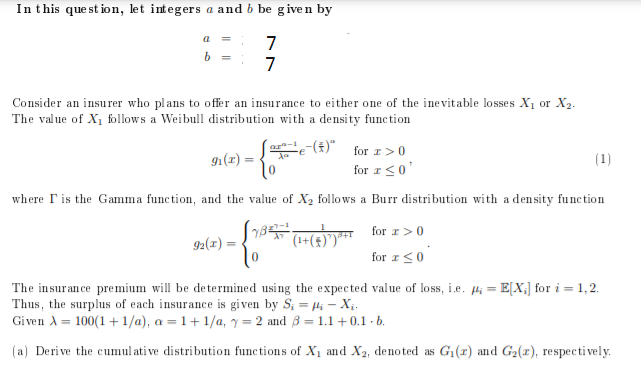

In this question, let integers a and b be given by a b 7 7 Consider an insurer who plans to offer an insurance to either one of the inevitable losses X1 or X2. The value of X, follows a Weibull distribution with a density function arente-(" for 1> 91(2) = (1) for I
92(2) for 150 (1+5)*7*** 0 The insurance premium will be determined using the expected value of loss, i.e. Hi = E[X] for i = 1,2. Thus, the surplus of each insurance is given by S; = Hi-X, Given ) = 100(1 +1/a), a = 1+1/a, 7 = 2 and 3 = 1.1 +0.1.b. (a) Derive the cumulative distribution functions of Xand X2, denoted as G(2) and G2(2), respectively, (b) For each of losses X and Y, find the premiums of the insurance, 41 and 42, respectively. (Hint: You can use Excel function GAMMA to calculate the value of the Gamma function. (c) By considering the cumulative distribution functions of Si, show that the density functions of S, and S2, denoted by fi and f2, are respectively given by fi(8) 91(441 - s) fa(s) 92(H2 - s) (d) For each possible surplus 8 =- -1000,-999,-9., [max{11,12}], calculate the respective values of loss X and X In this question, let integers a and b be given by a b 7 7 Consider an insurer who plans to offer an insurance to either one of the inevitable losses X1 or X2. The value of X, follows a Weibull distribution with a density function arente-(" for 1> 91(2) = (1) for I 92(2) for 150 (1+5)*7*** 0 The insurance premium will be determined using the expected value of loss, i.e. Hi = E[X] for i = 1,2. Thus, the surplus of each insurance is given by S; = Hi-X, Given ) = 100(1 +1/a), a = 1+1/a, 7 = 2 and 3 = 1.1 +0.1.b. (a) Derive the cumulative distribution functions of Xand X2, denoted as G(2) and G2(2), respectively, (b) For each of losses X and Y, find the premiums of the insurance, 41 and 42, respectively. (Hint: You can use Excel function GAMMA to calculate the value of the Gamma function. (c) By considering the cumulative distribution functions of Si, show that the density functions of S, and S2, denoted by fi and f2, are respectively given by fi(8) 91(441 - s) fa(s) 92(H2 - s) (d) For each possible surplus 8 =- -1000,-999,-9., [max{11,12}], calculate the respective values of loss X and X








